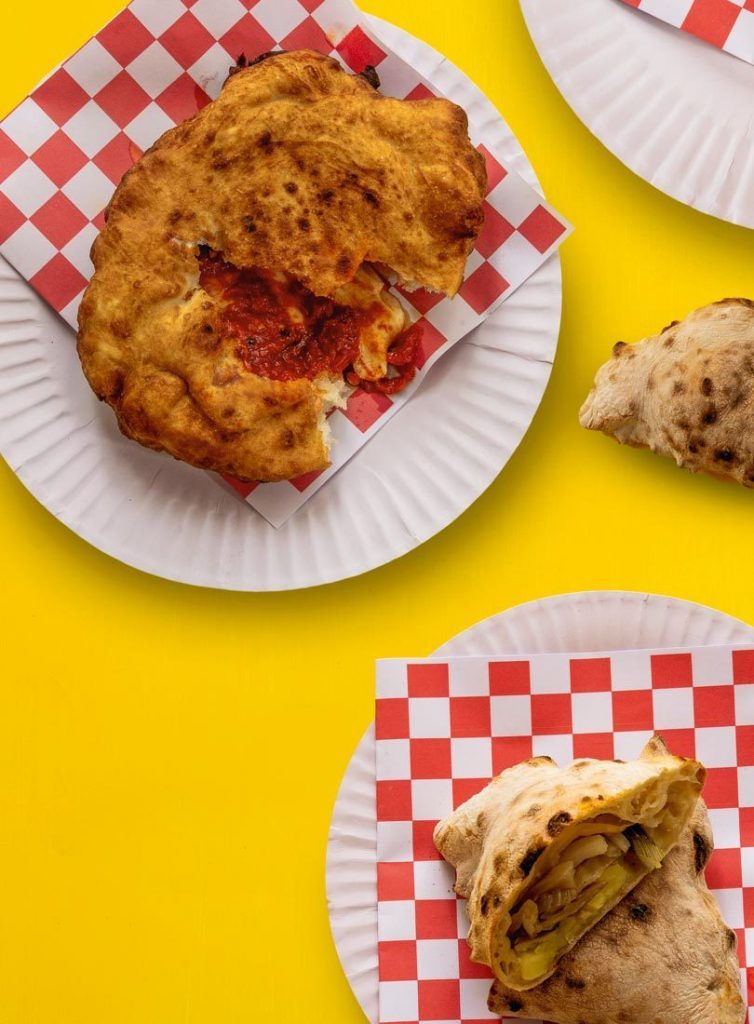SOURDOUGH PIZZA BASES
WILL BOWMAN & JANE LYONS

Makes
10x20 cmPreparation
50 minFermenting
72 hrsIngredients
| 620ml water, plus 50ml extra | |
| 150g sourdough starter | |
| 1kg tipo ‘00’ flour | |
| 25g salt |
This recipe makes 10 pizza bases, but can easily be halved or even quartered to make fewer. Or the dough can be left in the fridge after the last fold for up to 24 hours.
Instructions
| 1. | Mix 620ml of water, the starter and flour in a bowl until combined. |
| 2. | At this stage you want to let the dough rest for at least 30 minutes, but overnight in the fridge works well. |
| 3. | Once rested, dissolve the salt into the remaining 50ml of water and mix into the dough |
| 4. | The next step (the bulk fermentation) is critical to developing strength, flavour and structure in the dough. |
| 5. | For pizza bases, we find a longer, slower and colder fermentation works best. |
| 6. | So, once you’ve added the salt, cover and place in the fridge. |
| 7. | Over the next 48 hours, you need to fold the dough six times (the best way to approach this is to fold three times each day at even intervals). |
| 8. | There are many ways to fold a dough, but we’ve found the most effective method with a small batch like this is to wet your hands and push them, fingers first, down either side of the dough and lift it gently out of the bowl, letting it drape either side of your fingers. |
| 9. | Tuck these hanging down bits underneath, before placing the dough back in the bowl. During each fold, repeat this twice, rotating the dough 90 degrees between each lift. |
| 10. | You will notice that each time you remove the dough from the fridge for its next fold it will look and feel more light and billowy. With this in mind, it pays to be more gentle with each progressive fold, to ensure you don’t knock any of the carbon dioxide produced by the yeast out of the dough – these little pockets throughout the dough are what will give you the tender, chewy but light crust in the final product. |
| 11. | Once you’ve completed your final fold, keep the dough out of the fridge and rest for 30 minutes. |
| 12. | Dust a bench with flour, giving yourself plenty of room to work. Tip the dough onto the floured surface and use a dough scraper to cut the dough into 10 even pieces. If making the pizza fritta, further divide one of the 10 pieces into quarters, which will make two pizza fritta. |
| 13. | The next step – shaping the dough into rounds and building the final tension – takes practise but you will definitely get the hang of it. |
| 14. | Take a piece of dough, keeping it floured side down, and fold each of its four corners into its centre. Flip the dough onto a non-floured section of bench and rotate it on the spot so that it anchors itself to the bench, tightening itself into a more compact ball of dough. |
| 15. | Gently transfer to a floured tray with the dough scraper to rest for at least 30 minutes. |
| 16. | When ready to add the toppings and cook, place a ball of dough on a well-floured surface and gently press your fingers into it, starting in the middle, working outwards and leaving a centimetre or so for the crust. |
| 17. | Then gently stretch with your hands until the base is a few millimetres thick. |
| 18. | The reason for not using a rolling pin is to ensure you don’t crush all of the gasfilled holes within the dough that you’ve worked hard to create. |
| 19. | Now, to cook the bases you need a lot of heat. If you are lucky enough to have a pizza oven, then you’ll know all about this and won’t have to read any further. If you don’t, then you need to replicate the pizza-oven environment as closely as possible. |
| 20. | Use either a specific pizza stone, a wide, flat castiron pan or a terracotta tile to cook on. Turn your oven to its highest setting and select the grill function. |
| 21. | Place the stone, pan or tile 15-20cm below the grill and heat for 15 minutes. |
| 22. | This is what you’ll transfer your pizza onto for cooking. |
Recipes, food styling & photography Will Bowman & Jane Lyons
Tags: pizza, sourdough, Will Bowman, Jane Lyons

Leave a Reply